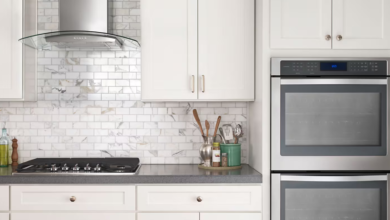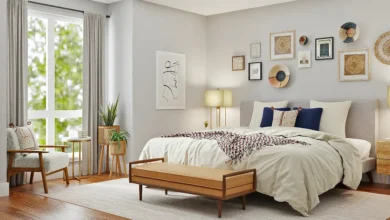How to Choose the Right Small Spaces for Your Home

In contemporary living, the area is regularly at a premium. Many people find themselves running with smaller living regions, whether or not due to urban dwelling, downsizing, or in reality the trend in the direction of a greater minimalist life. However, the proper technique can transform small areas into functional and fashionable areas. This guide will help you make the most of your small spaces, ensuring they are sensible and aesthetically pleasing.
Understanding Your Needs
Assess Your Lifestyle
Before you start decorating or rearranging, it’s critical to apprehend your way of life needs. Consider the subsequent:
Daily Activities: What sports will take place in this area? For instance, a small residing room may also need to house each relaxation and coffee interesting.
Family Dynamics: Are you living alone, with a companion, or with a family? Each situation may require specific area solutions.
Future Changes: Think approximately how your needs might evolve. Are you planning to have extra guests, or may you need a home office in the near destiny?
Define the Function of the Space
Every small area ought to have a clear characteristic. For instance:
Living Room: This should be a comfortable area for relaxation and socializing.
Bedroom: Needs to be a restful retreat with a good enough garage.
Office: Requires a prepared setup that promotes productiveness.
Maximizing Space Efficiency
Furniture Selection
Multi-Functional Furniture: Opt for portions that serve a couple of purposes. A sofa bed, for example, can double as a guest bed, and a coffee desk with storage can keep items out of sight.
Scaled Furniture: Choose fixtures that suit the dimensions of your area. Avoid outsized gadgets that could overwhelm a small room. Instead, go for smooth and narrow pieces that do not dominate the room.
Layout and Arrangement
Use Vertical Space: Install cabinets or shelves up to the ceiling to maximize the garage. Vertical preparations help hold floor space open.
Open Floor Plan: If feasible, create an open floor plan that permits a glide between specific regions. This technique makes the gap experience larger and greater linked.
Furniture Arrangement: Place large portions towards walls to preserve imperative areas open. Experiment with unique preparations to find what works quality to your wishes.
Storage Solutions
Built-In Storage: Utilize integrated shelves or shelving to shop floor area and hold your region muddle-free.
Under-Bed Storage: Use the gap under your bed for storage packing containers or drawers. This is good for gadgets you do not use day by day.
Overhead Storage: Consider installing cabinets above doors or in high corners to store less frequently used objects.
Design Strategies for Small Spaces
Color and Light
Light Colors: Light colorings, which include whites, lotions, and pastels, could make a small area sense large and extra open. Dark shades, whilst comfy, can make a space sense more restricted.
Mirrors: Strategically setting mirrors can create an illusion of extra space via reflecting mild and views. A huge replicate or a chain of smaller ones can visually extend a room.
Lighting: Use more than one mild asset, together with floor lamps, table lamps, and overhead lights, to embellish the space. Proper lighting fixtures could make a small room experience more inviting and much less cramped.
Texture and Patterns
Textures: Incorporate diverse textures to feature intensity and hobby to a small area. Soft rugs, textured cushions, and woven throws can create a comfortable atmosphere.
Patterns: Opt for smaller patterns or easy designs. Large or formidable styles can weigh down a small area and make it feel even smaller.
Personalization
Artwork and Decor: Personalize your area with artwork and decor that reflects your style. Just be mindful not to overdo it—choose some key pieces that complement the gap without cluttering it.
Plants: Adding greenery can convey life to a small space. Choose compact plants that do not require an excessive amount of space but add vibrancy.
Specific Solutions for Different Rooms
Small Living Rooms
Compact Seating: Consider a loveseat or a couple of armchairs instead of a huge sofa.
Wall-Mounted Furniture: Use wall-hooked-up tables and shelves to store floor space.
Expandable Tables: Opt for expandable or drop-leaf tables for dining areas that can be adjusted based on the variety of human beings the usage of the distance.
Small Bedrooms
Lofted Beds: In very small rooms, a lofted bed can loose up ground area for other makes use of.
Wall-Mounted Nightstands: Free up floor area with wall-established nightstands or floating cabinets.
Under-Bed Storage: Utilize containers or drawers beneath the mattress for additional storage.
Small Kitchens
Compact Appliances: Choose smaller appliances designed for compact areas, which include narrow fridges or unmarried-burner stoves.
Vertical Storage: Install shelves or cabinets above the countertop for an additional garage without taking up the floor area.
Fold-Down Tables: A fold-down desk or wall-mounted drop-leaf can offer dining space when needed but be tucked away while not in use.
Small Home Offices
Wall-Mounted Desks: Consider a wall-hooked-up desk or a fold-down desk that may be put away while no longer in use.
Vertical Storage Solutions: Use vertical shelving or pegboards to keep workplace resources organized without cluttering your desk place.
Ergonomic Furniture: Invest in compact yet ergonomic furniture that maximizes comfort without taking over an excessive amount of space.
Common Mistakes to Avoid
Overloading the Space
Too Much Furniture: Avoid cramming an excessive amount of furniture right into a small area. It could make the vicinity experience cluttered and much less practical.
Excessive Decor: Too many decorative items can crush a small room. Choose a few key pieces that beautify the space without causing a muddle.
Ignoring Scale and Proportion
Oversized Furniture: Large furniture portions could make a small room feel even smaller. Stick to appropriately sized furniture that fits the dimensions of the gap.
Too Many Patterns: Mixing too many patterns could make a small area feel chaotic. Opt for some coordinating patterns to maintain an experience of concord.
Lack of Storage Solutions
Neglecting Storage: Failing to plot for adequate storage can cause a cluttered and disorganized area. Incorporate smart garage solutions to keep your area tidy and practical.
Conclusion
Choosing the proper small spaces for your property includes an aggregate of knowledge your desires, maximizing area performance, and using thoughtful design strategies. By carefully selecting furnishings, optimizing layouts, and incorporating smart garage answers, you can create a small space that feels larger and greater cushty. Remember to customize your space with elements that mirror your style, and avoid commonplace pitfalls to make sure your small vicinity remains practical and inviting. With the proper method, even the smallest of areas can be transformed right into a charming and efficient part of your house.



